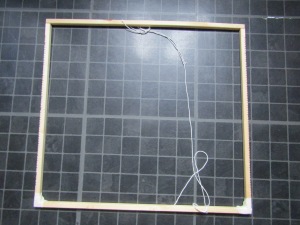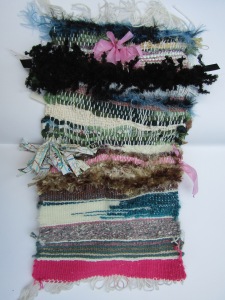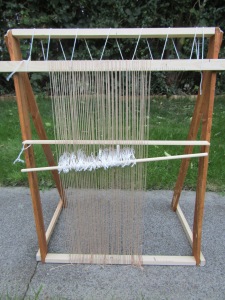Setting up the frame
 For me personally this included making the frame – for my first one I used two sets of tapestry bars purchased from Hobbycraft with lengths of 22 inches and 20 inches and slotted them together with masking tape binding for strength. I marked 1 centimetre intervals to a total of 25 centimetres and added small notches at each mark.
For me personally this included making the frame – for my first one I used two sets of tapestry bars purchased from Hobbycraft with lengths of 22 inches and 20 inches and slotted them together with masking tape binding for strength. I marked 1 centimetre intervals to a total of 25 centimetres and added small notches at each mark.
At this point I tied one end of my cotton dishcloth warp yarn and wrapped the yarn around the frame so I ended up with a total of 40 ends as per course instructions. What I did learn very quickly was to allow some extra for adjustment of tension to allow the shed sticks to be able to be used – it took some considerable time to go back and loosen up a little from the tight warp I initially did!
Tension of the warp is something I can only learn by experience but at the point of writing up I am starting to understand what works for me already.
 I made one simple shed stick with holes in which enabled it to be tied to either side of the frame and also a simple heddle with loops around to pick up the second shed warp threads – the latter cannot be seen in my photograph as at the point of taking it I had removed it but it did work to a satisfactory level. The heddle bar I discovered through an excellent blog which also gave me the ideas for how to make this simple loom.
I made one simple shed stick with holes in which enabled it to be tied to either side of the frame and also a simple heddle with loops around to pick up the second shed warp threads – the latter cannot be seen in my photograph as at the point of taking it I had removed it but it did work to a satisfactory level. The heddle bar I discovered through an excellent blog which also gave me the ideas for how to make this simple loom.
As per instructions I made a heading cord which formed the basis of my weaving and enables the threads to stay in the correct position – or not as I discovered as I did not get this process as accurate as experience will enable me to in the future! This heading cord is attached to either side of the frame and can be seen at the bottom of my photograph.
Stage 2
 Now to learn basic weaving techniques such as Soumak, Ghiordes knot and curves and also just simple weaving – the fun began!
Now to learn basic weaving techniques such as Soumak, Ghiordes knot and curves and also just simple weaving – the fun began!
Initially I just wove a few picks to get myself used to the process before beginning to experiment with the techniques suggested in the course material. My shed stick worked well as did the heddle bar but I did discover that I was pulling in the yarns at the selvedges too much and before my next sample took advice from other students as well as reading my books again in order to learn how to prevent this.
I cannot say I am a fan of Ghiordes knots as I find I simply do not have the patience for whole rows of it if I am brutally honest but did try small sections using strips of a map and also a pink plastic bag as well as cellophane. In addition I tried shading techniques and creating curves as well as experimenting with different yarns including the black one near the top which gives the effect of the Ghiordes knots without the individual strands although it was a nightmare to pull all the threads through!
In the sample I used a variety of yarns and materials including sheer voiles, strips of maps, strips of cellophane (I love the effect when combined with pink yarns), and raffia.
This is a sample I did to get to get the general feel of weaving as per the course instructions and the result is as intended.
The other benefit of the sample was to see how my loom worked but realised long term back problems was going to mean trying to make a better loom on some kind of A-frame that I could have on a table or desk at a reasonable height – the whiplash just reinforced this re-design but is meaning it will evolve further.
 My second frame I will blog separately but is shown on the left. I based it on images I found on the internet of looms various weavers had made but with simple relatively cheap materials and no direct instructions! Luckily my father often worked with wood in his garage and although I have no direct experience and this is as basic as it can get I was able to cobble something together that had the potential to work.
My second frame I will blog separately but is shown on the left. I based it on images I found on the internet of looms various weavers had made but with simple relatively cheap materials and no direct instructions! Luckily my father often worked with wood in his garage and although I have no direct experience and this is as basic as it can get I was able to cobble something together that had the potential to work.
Overall this has been an interesting introduction to weaving and as expected a very steep learning curve but also very enjoyable one too.
BIBLIOGRAPHY:
Burningham, V. 1998. Weaving Without a Loom. Tunbridge Wells, Kent. Search Press
Glasbrook, K. 2015. Tapestry Weaving. Tunbridge Wells, Kent. Search Press
Mallett, M. (date unknown). Reinventing the Loom: A Simple Frame for Experiments [online]. [Date accessed: July and August 2016]. Available from: http://www.marlamallett.com/loom.htm
